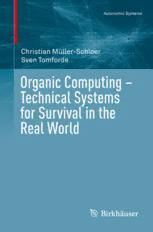
Organic Computing – Technical Systems for Survival in the Real World PDF
Preview Organic Computing – Technical Systems for Survival in the Real World
Autonomic Systems Christian Müller-Schloer Sven Tomforde Organic Computing – Technical Systems for Survival in the Real World Autonomic Systems SeriesEditors: FrancesM.T.Brazier(TUDelft,Delft,TheNetherlands) OmerF.Rana(CardiffUniversity,Cardiff,UK) JohnC.Strassner(POSTECH,Pohang,SouthKorea) EditorialBoard RichardAnthony(UniversityofGreenwich,UK) VinnyCahill(TrinityCollegeDublin,Ireland) MoniqueCalisti(MartelGmbH,Switzerland) SimonDobson(UniversityofSt.Andrews,UK) JoelFleck(Hewlett-Packard,PaloAlto,USA) JoséFortes(UniversityofFlorida,USA) SalimHariri(UniversityofArizona,USA) JeffKephart(IBMThomasJ.WatsonResearchCenter,Hawthorne,USA) ManishParashar(RutgersUniversity,NewJersey,USA) KatiaSycara(CarnegieMellonUniversity,Pittsburgh,USA) SvenvanderMeer(WaterfordInstituteofTechnology,Ireland) JamesWon-KiHong(PohangUniversity,SouthKorea) The Autonomic Systems series aims at creating a platform of communication betweenuniversitiesandindustrybypublishingresearchmonographs,outstanding PhDtheses,andpeerreviewedcompiledcontributionsonthelatestdevelopmentsin thefield.Itcoversabroadrangeoftopicsfromthetheoryofautonomicsystemsthat areresearchedbyacademiaandindustry.Hence,cutting-edgeresearch,prototypical case studies, as well as industrial applications are in the focus of this series. Fast reviewing provides a most convenient way to publish latest results in this rapid movingresearcharea. Moreinformationaboutthisseriesathttp://www.springer.com/series/8123 Christian MuRller-Schloer (cid:129) Sven Tomforde Organic Computing – Technical Systems for Survival in the Real World ChristianMuRller-Schloer SvenTomforde InstituteofSystemsEngineering IntelligentEmbeddedSystemsGroup LeibnizUniversitätHannover UniversitätKassel Hannover Kassel Germany Germany AutonomicSystems ISBN978-3-319-68476-5 ISBN978-3-319-68477-2 (eBook) https://doi.org/10.1007/978-3-319-68477-2 LibraryofCongressControlNumber:2017955542 ©SpringerInternationalPublishingAG2017 Thisworkissubjecttocopyright.AllrightsarereservedbythePublisher,whetherthewholeorpartof thematerialisconcerned,specificallytherightsoftranslation,reprinting,reuseofillustrations,recitation, broadcasting,reproductiononmicrofilmsorinanyotherphysicalway,andtransmissionorinformation storageandretrieval,electronicadaptation,computersoftware,orbysimilarordissimilarmethodology nowknownorhereafterdeveloped. Theuseofgeneraldescriptivenames,registerednames,trademarks,servicemarks,etc.inthispublication doesnotimply,evenintheabsenceofaspecificstatement,thatsuchnamesareexemptfromtherelevant protectivelawsandregulationsandthereforefreeforgeneraluse. Thepublisher,theauthorsandtheeditorsaresafetoassumethattheadviceandinformationinthisbook arebelievedtobetrueandaccurateatthedateofpublication.Neitherthepublishernortheauthorsor theeditorsgiveawarranty,expressorimplied,withrespecttothematerialcontainedhereinorforany errorsoromissionsthatmayhavebeenmade.Thepublisherremainsneutralwithregardtojurisdictional claimsinpublishedmapsandinstitutionalaffiliations. Printedonacid-freepaper ThisbookispublishedunderthetradenameBirkhäuser,www.birkhauser-science.com TheregisteredcompanyisSpringerInternationalPublishingAG Theregisteredcompanyaddressis:Gewerbestrasse11,6330Cham,Switzerland Verumquiafactum GiambattistaVico 1668–1774 Foreword The world is experiencing a fundamental transformation due to the tremendous development of information and communication technologies. As almost every area of our society and our economy gets affected by “digitalisation”, the digital infrastructure is considered meanwhile to be one of our critical assets which are key to societal and economic competitiveness and well-being. Anticipating this development, industrial and research communities worldwide have initiated research and development programmes in order to be able to cope with new challenges arising from the technical innovation. In particular, at the beginning of this century, the Community of Computer Engineering within the German Informatics Society identified the need for new system architectures and com- putational methods in order to deal with the emerging multitude of interacting intelligent devices which will have to provide essential functionality in various technical application areas. This resulted in the national research programme on “Organic Computing” funded by the German Research Foundation from 2005 to 2011 as one of its priority programmes. While further closely related initiatives such as “Cyber-physical Systems” or “Industrie 4.0” emphasise the influence of informationandcommunicationtechnologiesonclassicalengineeringoftechnical application systems, the Organic Computing Initiative focuses on the need for system architectures and methodologies that enable the combined presence of autonomyandcontrolledself-organisation,allowingforan“organic”adaptationof thesystembehaviourtochangingrequirementsofitsoperatingenvironmentwhile providingappropriateinterfacesforpotentiallynecessarycontrolledinteractionwith humanusersorotherentitiesonhighersystemlevels. It has been a privilege to have been able to shape this fascinating new branch of science in close cooperation with many colleagues. After major results of the priority programme have been published as a large compendium on Organic Computing—AParadigmShiftforComplex Systems, the presentbookon Organic Computing—Technical Systems for Survival in the Real World combines the content of courses at the universities of Augsburg, Hannover, and Kassel into a vii viii Foreword comprehensive textbook, providing an excellent introduction into system tech- nologies that are of highest relevance for coping with the inherent technological challengesofdigitalisation. Karlsruhe,Germany HartmutSchmeck July2017 Preface So far, Organic Computing (OC) literature has been published with the OC researcher in mind. Although the existing books have tried to follow a didactical concept,theyremaincollectionsofscientificpapers.Acomprehensiveandsystem- aticaccountoftheOCachievementsintheformofatextbook,whichlendsitselfto thenewcomerinthisfield,hasbeenmissingso far.Whenweconceivedthisbook wehadprimarilyourmasterstudentsinmind.Thecontenthasbeencompiledfrom severallecturesinOrganicComputingheldattheLeibnizUniversitätHannover,the UniversityofAugsburg,andtheUniversityofKassel. OC is a systems science, i.e. it deals with the problem of integrating certain component techniques into a coherent whole. OC is interested in the overall architecture of technical systems able to survive in the real world. Critics might claim that OC is nothing but integration with the component techniques being investigated in the respective special fields. Hence OC—as all the other systems sciencesaswell—somehowvanishesinbetween.Weareconvinced,however,thatin additiontothetraditionalanalyticalandspecialistapproachtheaspectofintegration will become more important as we enter the era of mega-complex systems. A classical divide-and-conquerapproachwill not suffice when we have to deal with semi-autonomoussub-systemswitheach ofthese systemsconsistingof thousands ofsub-systemsagain.Theonlysystemweknowofthatapparentlyhassolvedthis problemislife—andthekeyabilityoflivingsystemsisembodiedintheirholonic character.Thisiswhywestrivetounderstandsomeconstructionprinciplesofliving systemsinordertoapplyittoourtechnicalsystems. Inthisbook,wefirsttrytoconveytothereaderafeelingofthespecialcharacter ofnaturalandtechnicalself-organisingandadaptivesystemsthroughalargenumber ofexamples.Thenwediscussquantitativeaspectsofsuchformsoforganisation,and finally,weturntomethodsofhowtobuildsuchsystemsforpracticalapplications. Werealisethattheveryactiveareaofself-organisingadaptivesystemsislargerthan what we could accommodate in this book. We have at least briefly characterised someneighbouringresearchfieldsinthechapteronTheMajorContext.Ingeneral, theselectionoftopicsfollowedthedidacticalconceptadoptedinourOClectures. ix x Preface Wedoapologiseforhavingleftoutmanyrelevantideasandtechniquesduetospace restrictions. Mostofthecontentofthisbookhasbeenpublishedbeforesomewhereelse.The originalliteratureisreferencedinthetext,especiallyintheFurtherReadingsection attheendofeachchapter.Thematerialhasbeenrearrangedforthisbook,enriched withmaterialsfromthelectureslides,andthenomenclaturehasbeenunified. Howto Read ThisBook ThetargetreaderofthisbookisthemasterstudentinComputerScience,Computer Engineering, or Electrical Engineering—or any other newcomer to the field of OrganicComputingwithsometechnicalorComputerSciencebackground.Readers canseek accesstoOC ideasfromdifferentperspectives:OCcanbe viewed(1)as a “philosophy” of adaptive and self-organising—life-like—technicalsystems, (2) as an approach to a more quantitative and formal understandingof such systems, and finally, (3) as a construction method for the practitioner who wants to build such systems. In order to support these different perspectives, reading styles, and depths of penetration, we have preceded the chapters and major sections with “Aboutthischapter”boxes.Theyaremeantasaquickorientationasto“Why”this chapteris neededin the contextof the book,“What” the contentis, and“Who” is recommendedtoreadit. RecommendationsforFurtherReadingaregivenattheendofeachchapter. Wehavedecidedtolistthereferencesattheendofeachchapter.Whilethisleads topossiblymultiplecitationsofsomepapers,itprovidesmorelocalityandacloser relationshipofthereferenceswithinthecontextofthesinglechapters. Excellence is the result of extensive corrections! We have taken utmost care to eliminate errors, typos, and other mistakes—as far as possible. But there will be,nodoubt,[email protected] [email protected]. Hannover,Germany ChristianMüller-Schloer Kassel,Germany SvenTomforde August2017
